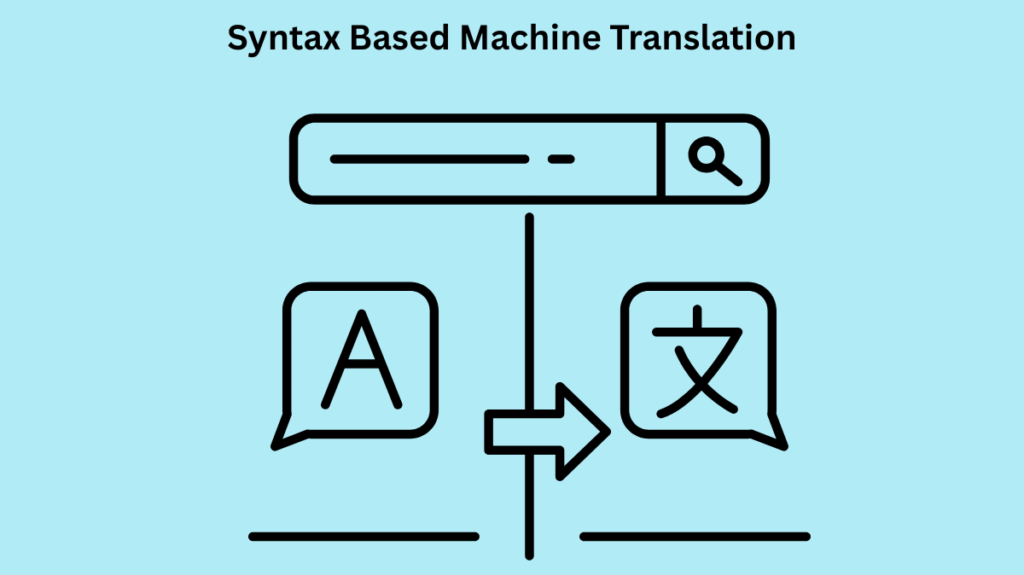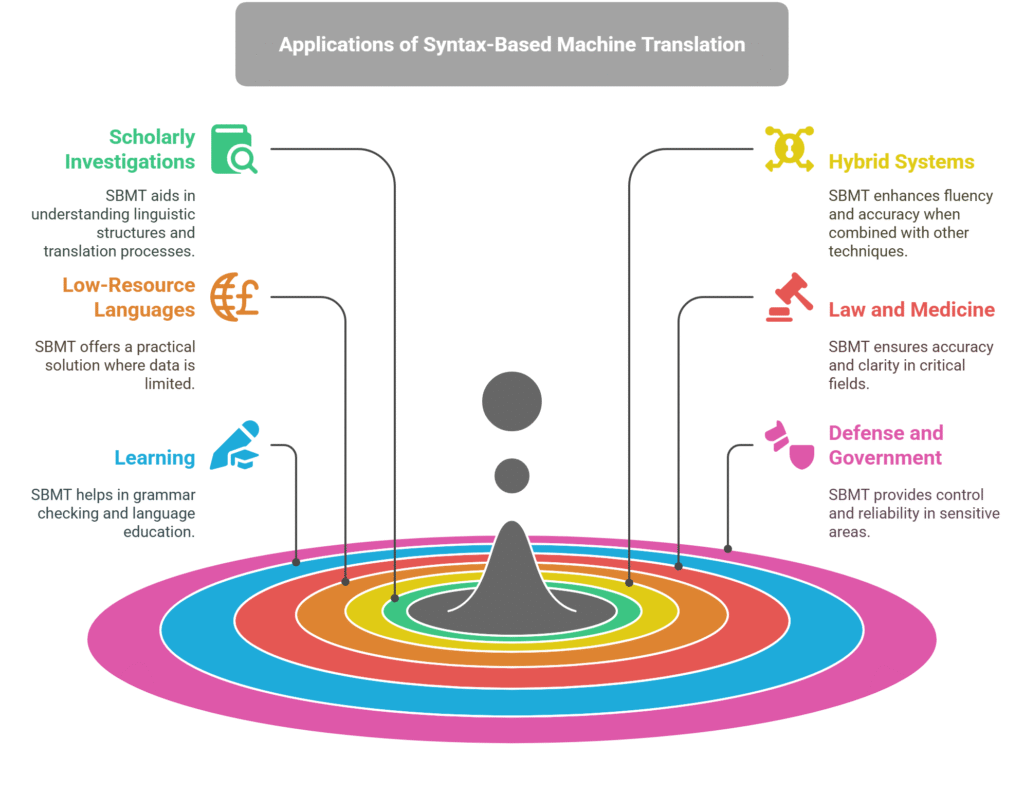SBMT meaning
Machine translation (MT), an NLP branch, automates language translation. Syntax Based Machine Translation(SBMT), one of the MT methods, emphasizes sentence grammar. Linguistic syntax helps SBMT translate more accurately, semantically, and grammatically.
What Is Syntax Based Machine Translation?

Syntax based machine translation(SBMT) uses grammar rules and parse trees to guide translation. SBMT translates sentences by understanding word relationships in a sentence’s grammatical structure, unlike previous approaches that use alignments.
SBMT holds that a deeper understanding of syntax leads to more accurate translations, especially between languages with very diverse word ordering, grammars, or structural components. Japanese uses SOV, while English uses SVO. Syntax-based models can adjust translated text to account for this mismatch.
How Syntax Based Machine Translation Works?
The following crucial procedures are followed by syntax-based translation systems:
Breaking Down the Original Sentence
First, parse the sentence in the source language with a syntactic parser. This parser shows how each word fits into the sentence’s syntactic tree. It recognizes subjects, verbs, objects, phrases, and clauses, for instance.
Mapping Grammar Rules
The system maps the source tree to a target tree using synchronous context-free grammar (SCFG) or other grammatical rules after the syntactic structure is available. Parallel corpora, which are aligned sentences in two languages, are frequently used to teach these grammatical rules.
Producing the Desired Sentence
The mapped target tree is subsequently linearized, which preserves the target language’s grammatical structure while converting it into a string of words.
After-Processing
To improve the output by correcting formatting, agreement, or punctuation based on extra language models or rules, some systems incorporate a post-processing stage.
Learn more on Grammar Correction NLP & What Is Question Answering In NLP
Types of Syntax-Based Models
Three primary categories of SBMT models exist:
String-to-Tree
- A string is used to represent the input.
- In the target language, the output is produced as a tree structure.
- Beneficial when there are stringent syntactic requirements in the target language.
Tree-to-String
- A syntactic tree is created by parsing the original text.
- A string is produced as the output.
- Aids when the source language has a rich syntactic structure.
Tree-to-Tree
- Tree parsing is used for both source and target sentences.
- One syntax tree is mapped to another via a tree-to-tree transduction.
- Provides the best level of linguistic accuracy but comes at a hefty computational cost.
Advantages of Syntax Based Machine Translation

- Correctness of Grammar: Syntax Based Machine Translation(SBMT) methods explicitly model sentence structure to preserve grammatical integrity. This is particularly useful for avoiding difficult or improper sentence structures.
- Improved Reordering: Compared to phrase-based or statistical systems, SBMT is stronger at handling long-distance reordering, which makes it perfect for language pairs with diverse word orders.
- Preservation of Semantics: By comprehending the hierarchical links between sentence components, syntax trees aid in maintaining the sense of sentences.
- Explainability: Because grammar rules and syntax trees are understandable by humans, SBMT is easier to interpret than neural models. Both academic research and debugging benefit from this.
- Language Support with Limited Resources: SBMT can nevertheless function rather effectively with handcrafted or rule-based grammar in languages without big parallel corpora.
Learn more on RBMT In NLP: Understanding Rule-Based Machine Translation
Disadvantages of Syntax-Based Machine Translation
- Dependency on Parsers: Syntactic parser quality has a significant impact on SBMT performance. The quality of the translation drastically declines if the parser produces errors.
- Resource-Heavy: It takes a great deal of linguistic knowledge and computer power to create and maintain syntax trees, grammar rules, and alignment models.
- Limited Adaptability: Text that is casual, loud, or grammatically incorrect like social media messages or spoken language transcripts is difficult for Syntax Based Machine Translation(SBMT) to understand.
- Problems with Scalability: It is more difficult to scale to several languages since new parsers and grammar rules need to be created or modified for each new language combination.
Challenges in Syntax-Based Machine Translation
Quality of Parsers in All Languages
High-resource languages, such as English and French, have sophisticated parsers. SBMT’s use is constrained by the fact that parsers for many languages are either nonexistent or inadequately developed.
Structures in Alignment
Due to variations in word construction, idioms, and syntax, mapping syntactic trees between two languages is not always simple.
Syntax Ambiguity
Syntax can be unclear even within a single language. For instance, there are multiple ways to understand the statement “Visiting relatives can be boring.” It is difficult to disambiguate such formations.
Adaptation of Domains
Domain-specific grammatical rules differ (e.g., legal vs. medical vs. casual language). Complexity is increased by developing domain-specific syntactic rules.
Learn more on Application of FeedForward Neural Network And Advantages
Syntax-Based Machine Translation Applications

Even if neural techniques have recently taken centre stage, SBMT is still crucial for a number of applications:
- Scholarly Investigations: One of the most important areas of linguistic research is still SBMT. It offers a starting point for comprehending how syntactic characteristics affect language creation and translation.
- Hybrid and Rule-Based Systems: Some hybrid systems enhance fluency and grammatical accuracy by combining SBMT with statistical or neural techniques.
- Languages with Limited Resources: SBMT provides a structured and practical substitute for neural systems in many low-resource languages where training data is limited.
- Translation for Law and Medicine: Compared to purely statistical or neural systems, SBMT produces more regulated and interpretable results in fields that demand accuracy and structural clarity.
- Learning: Syntactic models are frequently used in grammar-checking software and language learning resources to assist users in comprehending sentence structure and enhancing their translation understanding.
- Defense and Government: SBMT is used by organizations with stringent control, explainability, and accuracy requirements where neural systems may be too ambiguous or unreliable.
In conclusion
A layer of grammatical knowledge is added to the translation process by the linguistically rich method known as syntax based machine translation. SBMT is still useful because of its explanation, structure-aware output, and efficacy in low-resource or specialised sectors, even if contemporary Neural Machine Translation (NMT) has produced outstanding results in terms of fluency and scale. Future advancements might be found in hybrid systems that give the best of both worlds by fusing the learning capabilities of neural networks with the grammatical rigour of syntax-based models.
